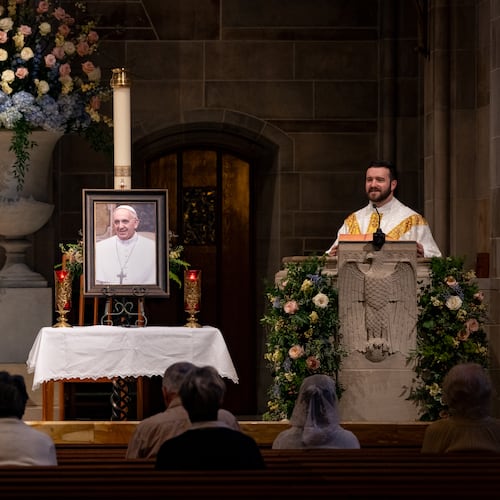BAINBRIDGE - Eric Cohen was 7 when Hurricane Kate roared up from the Florida Panhandle and crashed into his father’s pecan orchards.
“Kate destroyed the farm pretty bad. It was the storm we always feared,” he said of the 1985 disaster.
Hurricane Michael, he said, “was 10 times worse.” The storm slammed into the Panhandle on Oct. 10 at Category 4 strength and was still Category 3 as it crossed into Georgia. Kate was Category 2 at landfall and reached Georgia at Category 1.
“They always tell you, ‘the storm’s coming, it’s coming, it’s going to be horrible.’ It always seems to weaken,” Cohen said “This one did nothing but get stronger.”
Michael is blamed for at least 35 deaths, including 25 in Florida, six in Virginia, three in North Carolina and one in Georgia. The funeral for Sarah Radney, who died when strong winds struck her grandparents’ house near Lake Seminole, was held last week in Cairo. She was 11.
The powerful storm also flattened trees, demolished crops and destroyed chicken coops throughout southwest and middle Georgia. Agriculture industry losses could reach nearly $3 billion, according to the University of Georgia Cooperative Extension Service and Georgia Forestry Commission.
“It’s weird that a hurricane hit us,” said Leesburg pecan farmer Marianne Brown. “For a hurricane to hit this part of Georgia is really unheard of.”
But experts say as hurricanes are becoming stronger and wetter, meaning they will threaten areas further from the beach.
“The first thing we’re going to do is knock down the myth that hurricanes are a coastal event,” said National Hurricane Center spokesman Dennis Feltgen. “As these storms move inland and have all that energy, it does take time for that atmospheric energy to power down. That was a major player in Michael.”
A history-making storm
Michael is only the fifth major hurricane, defined as Category 3 or higher, to strike Georgia since reliable record keeping began in 1851, said Severe Weather Team 2 Meteorologist Brad Nitz. The other four struck in the 1800s.
“This is the first time in about 120 years there’s been a major hurricane in Georgia,” he said.
Michael is also the strongest hurricane to make landfall on the Florida Panhandle since record keeping began.
“Hurricane Michael was unique in that it was so strong,” Nitz said. “The water temperature as Michael came through was in the mid-80s, some of the warmest water of the year. It’s the warm water that fuels not only the development but the strengthening of a tropical storm and hurricane.”
Nitz said atmospheric conditions were ideal.
“It continued to intensify and strengthen all the way up to the point that it made landfall on the Florida Panhandle, and it did so at the top of the Category 4 scale with sustained winds of 155 miles an hour, just shy of Category 5.”
Official “inland hurricane warnings” are relatively new alerts from the National Weather Service; in years past such areas would have been put on notice for high winds or flooding, Nitz said.
MORE: Download the WSB Weather App here.
Still, Michael’s long reach took residents unaccustomed to hurricane warnings by surprise.
"We had hurricane warnings in middle Georgia," said Trent Mason, who farms in Macon, Peach and Houston counties said. "It seems extremely weird."
Warmer water, stronger storms
Kevin Trenberth, distinguished senior scientist at the National Center for Atmospheric Research, has compiled a vast body of research on climate change and hurricanes. He detailed his findings in a Scientific American article grimly titled “New data: Hurricanes Will Get Worse” earlier this year, and spoke to The Atlanta Journal-Constitution this week.
“If the oceans are warmer, that’s fuel for the storm,” he said. “The storms get more intense. They also get bigger, they also last longer. The fact that the Panhandle had not been hit in quite the same way before is probably largely chance. It’ll happen sooner or later in your neck of the woods.”
Michael’s size was less remarkable than its reach.
“It was not one of the biggest storms by any means,” Trenberth said, adding that the storm’s long reach inland was notable.
“I don’t think I’ve seen anything quite like Michael before as it was powering up,” he said. “If I were a farmer in the interior of the state I would worry most about the flooding risk and have good drainage systems and maybe deep ponds where you can store water. What happens with a hurricane is you have too much water and then three months later you’re in a drought. Managing water is one of the key issues with climate change.”
Nitz urges people to pay close attention to warnings, and to note that hurricane preparation isn’t limited to coastal evacuations.
“Inland, those wind threats are substantial,” he said. “We saw tornado-like damage across a large swath of south and southwest Georgia from the winds from Hurricane Michael. Any time we’ve got one of these powerful hurricanes or severe weather events, we really strongly encourage you to seek shelter, take the actions that we recommend. We really strongly encourage you to always take these seriously.”
Moving on
State officials warn recovery will be a long process.
“Georgia has long led in the production of several renowned commodities and now we have the dubious distinction of also leading in the devastation and incredible loss of these prominent crops,” Agriculture Commissioner Gary Black said in a statement. “These are generational losses that are unprecedented and it will take unprecedented ideas and actions to help our farm families and rural communities recover.”
Greg Calhoun farms in Miller, Decatur, Seminole, Baker and Early counties and doesn’t yet know exactly how bad he’s been hit; he hasn’t been able to get to all of his acreage to assess damage. He knows it’s bad, though.
“I know I’ve got dead cows I can’t get to. The only thing I’ve seen that would compare to this is maybe Puerto Rico, on TV,” he said, referring to Hurricane Maria. “Everything’s mangled up.”
His cotton fields are picked clean, the crop strewn and soggy. He’s trying to salvage what corn he can. He feels most optimistic about the peanuts, but his irrigation equipment is bent and crumbled. Among his most pressing items is repairing the miles of fence and rounding up his surviving cattle.
“I’ve kind of had them on the honor system,” he said. “It didn’t work very well.”
Brown, the Leesburg pecan farmer, was on the cusp of a bountiful crop when Michael hit.
“We had everything mowed. Limbs were picked up, the equipment was ready to go,” she said. “It went from beautiful and pristine and everything looking perfect to a total catastrophe.”
Like many others in the industry, farming for her is a generational concern. She majored in advertising with an agriculture minor at the University of Georgia and came back after school.
“Driving home from UGA, when I would hit Macon and Fort Valley, I just felt like I could breathe better,” she said. Today she and her husband farm 200 acres and help her dad with his 800. Moving on past Michael presents uncertain challenges.
“Do you go in there and pick up all the tree limbs as fast as you can to pick up the nuts? Or do you go really slow and possibly take four to six months and try to not run over the pecans and then try to harvest,” she said. “The longer you wait with nuts on the ground, the poorer the quality. I feel very defeated.”
She hopes that Michael will remain one for the record books instead of a harbinger of calamity to come.
“We’re trying to stay positive. You can’t control the weather. It’s an act of God,” Brown said. “I hope in the future I can always look back and say, ‘it wasn’t as bad as Hurricane Michael in 2018.”
About the Author
The Latest
Featured

